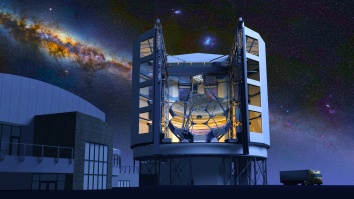Students Andrew Peterson (left) and Ingrid Johnson (right), with Research Associate Trent Peterson (center), at work in the lab.
McDonald Observatory Astronomers Advise National Research Council
10 October 2014
AUSTIN — Astronomers from McDonald Observatory are providing input to the National Research Council (NRC) on a variety of topics in response to a community-wide request from the council in late August. The NRC has a committee on optical and infrared astronomy that is seeking input on topics important to the future of the field in the United States in the era of the forthcoming Large Synoptic Survey Telescope (LSST).
“UT-Austin welcomes this opportunity to share our achievements and perspectives on the future with this important committee,” said Dr. Taft Armandroff, Director of McDonald Observatory. “Its findings will help shape the future of U.S. astronomy.”
The observatory’s input to NRC takes the form of four white papers on various topics, detailed below. The Giant Magellan Telescope (GMT) Organization, of which McDonald Observatory is a founding member, has also submitted a pair of white papers.
Armandroff and GMT Director Dr. Patrick McCarthy have been invited to present at the committee’s meeting on October 12 and 13 in Irvine, Calif. The committee includes Dr. J. Craig Wheeler, the Samuel and Fern Yanagisawa Regents Professor in Astronomy at The University of Texas at Austin.
Details on the papers, and links to read them, are available below.
— END—
Submitted papers include:
Telescopes and Instruments at McDonald Observatory
The telescopes and instruments available at McDonald comprise a powerful resource with some unique capabilities for addressing the priority scientific issues of the U.S. astronomy community. McDonald Observatory is prepared to participate in a national clearinghouse whereby we could offer some time with our telescopes to the broad U.S. community and secure in return either funding for instrumentation development or access to observing time elsewhere with capabilities not available at McDonald. [Click to access this white paper by Dr. Taft Armandroff.]
Instrument Development at McDonald Observatory
New instrumentation development is vital to maximizing the scientific productivity of an observatory and aligning it with the competitive scientific environment. McDonald Observatory conducts a vigorous program of advanced instrumentation development. Federal funding for developing new instrumentation is very important to maintaining the vitality of U.S. independent observatories such as McDonald. [Click to access this white paper by Drs. Taft Armandroff, Gary Hill, Dan Jaffe, and Phillip MacQueen.]
Training at McDonald Observatory
The University of Texas astronomy program excels at offering opportunities for hands-on observing and instrumentation development for students and early career scientists. [Click to access this white paper by Drs. Sarah Tuttle, Cynthia Froning, Hanshin Lee, and Mike Montgomery.]
Software Development at McDonald Observatory
Software development plays a key role in today’s observatory in the modern era of big data, and merits special consideration. [Click to access this white paper by Drs. Niv Drory, Matthew Shetrone, and Niall Gaffney.]
GMT’s Breakthrough Observing Capabilities
This paper outlines the GMT’s breakthrough observing capabilities and presents the opportunity for one or more federal agencies to partner with GMT. [Click to access white paper by the GMT Board, including Dr. Taft Armandroff and UT-Austin Dean of Natural Sciences Dr. Linda Hicke.]
GMT’s Role in the U.S. Observing Community
This paper outlines the GMT’s role in the U.S. Optical and Infrared System and its relation to other major facilities, including the forthcoming Large Synoptic Survey Telescope (LSST.) [Click to access the white paper by the GMT Scientific Advisory Committee, including Dr. Anita Cochran.]









